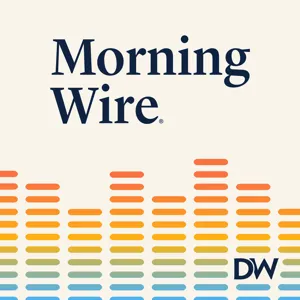Podcast Summary
Exploring Music's Deeper Meaning and Productivity Tools: The podcast 'Dissect' discusses music's deeper meaning and the helpfulness of using Canva for creating presentations. Chronic absenteeism in schools, affecting 1 in 4 public school students, is a more fundamental crisis that requires attention.
The podcast "Dissect" explores the deeper meaning behind popular music by analyzing the lyrics and melodies of one song per episode from a full album. Hosted by Cole Kushner, the podcast has covered artists like Kendrick Lamar, Radiohead, Beyonce, and MF Doom. In a recent episode, Kushner discussed his personal struggle with creating visual presentations and the helpfulness of using Canva, an AI-powered tool for creating stunning slides quickly and easily. The episode was also sponsored by Indeed, which emphasizes the importance of connecting with job candidates efficiently. Another intriguing topic Kushner touched upon was the issue of chronic absenteeism in schools, which has significantly increased since the pandemic. In Washington D.C., for instance, 60% of high school students were chronically absent this year, meaning they missed one day of school every 2 weeks. This problem, which affects both students and teachers, has worsened nationwide, with 1 in 4 public school students now considered chronically absent. This issue, while related to the learning loss problem and disruptive behavior in schools, is a more fundamental crisis that requires attention.
Impact of the pandemic on chronic absenteeism: The pandemic exacerbated the issue of chronic absenteeism, with some students' attendance becoming optional, beyond illness reasons.
The pandemic has led to a significant increase in school absences, with approximately one in six students missing 10% of the school year before COVID. This issue, known as chronic absenteeism, was already a concern before the pandemic, but the situation has worsened. The reasons for this trend go beyond illness, as some students' relationship with school has become optional. Psychologist Katie Rosenbaum explained that there's been a fundamental change in the value we place on attending school. Nat Malkus, a former teacher and deputy director of education policy at the American Enterprise Institute, has been tracking the impact of the pandemic on schools and shares insights on why this matters and what teachers and lawmakers can do about it.
Chronic absenteeism and its impact on students before the pandemic: Chronic absenteeism in 8th grade was a strong predictor of high school graduation. Factors like poverty, race, and district type contributed to higher absenteeism rates, with lower-achieving and higher-poverty districts and Black and Hispanic students being more likely to be chronically absent.
Chronic absenteeism, or missing a significant amount of school, was a problem before the pandemic and had negative impacts on academic outcomes and long-term success for students. Research conducted before the pandemic showed that chronic absenteeism in 8th grade was a strong predictor of high school graduation, and absenteeism rates varied greatly across states. Factors such as poverty, race, and type of district contributed to higher absenteeism rates. For example, lower-achieving and higher-poverty districts had higher chronic absenteeism rates, and Black and Hispanic students were more likely to be chronically absent. The pandemic exacerbated this issue, with some school leaders and parents pushing for school closures, leading to even more missed instructional time. It's important to note that the definition of an absence can vary from district to district, making comparisons between states and districts challenging. However, the underlying factors contributing to chronic absenteeism, such as poverty and race, were present before the pandemic and continue to be significant factors.
The Impact of COVID-19 on US Education: School Closures and Remote Learning: The COVID-19 pandemic led to widespread school closures and varying degrees of remote learning, causing significant learning loss and chronic absenteeism, particularly in districts that relied heavily on remote instruction.
The COVID-19 pandemic had a significant impact on education in the United States, leading to widespread school closures and varying degrees of remote learning. The first year of the pandemic saw most schools shutting down entirely, leaving students in a suboptimal learning environment for a considerable period. The following year brought about significant differences in school closures, with urban districts and those with more liberal policies closing for longer periods. While remote learning was not ideal, being in school was not without its challenges, including quarantines, staffing issues, and cultural conflicts. Research shows that districts that relied more on remote learning experienced greater learning loss, which was a common issue across the board. As schools reopened in 2021, the effects of the pandemic continued to be felt in increased chronic absenteeism. The education landscape during the pandemic was complex and varied, with significant differences based on geography and policy.
Absenteeism surge during omicron variant not limited to remote learning schools or low-income districts: Absenteeism during the 2021-2022 academic year surged by nearly 90%, affecting over a quarter of K-12 students, regardless of school type or socioeconomic status.
The widespread issue of absenteeism in schools during the 2021-2022 academic year, particularly during the omicron variant surge, was not solely attributed to remote learning or school closures. While there was a correlation, the increase in absenteeism was a pervasive problem across various districts, regardless of their remote learning policies or socioeconomic status. The absence rate surged by nearly 90% from pre-pandemic levels, affecting over a quarter of K-12 students. This was a concerning trend as it was not limited to specific types of schools or districts.
The pandemic may have normalized staying home: The pandemic's cultural shift may be contributing to increased chronic absenteeism among students by normalizing staying home and expanding permission structures to do so.
The surge in students not showing up to school is a universal issue across the country, and it's not due to one specific cause. While illness and transportation difficulties are contributing factors, the underlying issue may be the cultural shift that occurred during the pandemic. With more flexible work arrangements and fewer obligations to attend institutions like offices or churches, the permission structure to stay home expanded. This cultural shift, along with the continuation of pandemic-era policies, may be leading to increased chronic absenteeism among students. It's important to note that this theory is not scientifically proven, but it offers a potential explanation for the trend. The pandemic may have normalized the idea that staying home is an acceptable option, making it more challenging to get students back to attending school regularly.
Remote learning and working leading to more absences - 'flaking out': The shift to remote learning and working has resulted in increased absences, particularly for children, due to the removal of routines and weakened social gravity, with additional disruptions caused by illnesses.
The shift to remote learning and working has led to changes in attendance norms, with people, especially children, experiencing more absences due to various reasons. This phenomenon, often referred to as "flaking out," is a response to the removal of pre-pandemic routines and the weakening of the social gravity that pulls people to institutions like schools and workplaces. This dynamic is more significant for children, as they rely on schools for education and social development, and the lack of connection to these institutions can have long-term consequences. Additionally, the increase in illnesses, such as COVID, adenovirus, and RSV, has added to the disruption of family life and normal school attendance.
Changes in school attendance norms during the pandemic: The pandemic has led to increased teacher and student absenteeism, requiring stakeholders to recognize and address this cultural shift to prioritize regular attendance for children's educational success.
The pandemic has led to significant changes in norms around attendance in schools, with both teachers and parents contributing to the issue. Teacher absenteeism has increased, making it more challenging for educators to set expectations and address cultural shifts. Meanwhile, parents seem to be normalizing chronic absenteeism among their children. This trend is concerning as it can negatively impact children's education and long-term success. It's crucial for stakeholders to recognize this cultural shift and work together to reverse it. Parents must take responsibility for their children's attendance, and schools and communities should support them in doing so. The pandemic has highlighted the importance of strong education systems and the need for ongoing efforts to maintain norms that prioritize regular attendance.
Chronic absenteeism and its impact on education: Despite the shift to homeschooling and school closures during the pandemic, chronic absenteeism and learning loss remain significant issues. Emphasize long-term consequences and consistent attendance for quality education.
Chronic absenteeism and the resulting learning loss in schools are significant issues that cannot be ignored. The cultural shift towards homeschooling and the closure of schools due to the pandemic have exacerbated these problems. Although homeschooling may be a factor in explaining some of the jumps in chronic absenteeism and learning loss, it is not the sole cause. The National Assessment of Education Progress reported historic drops in national test scores for 13-year-olds, and school closures have been called the most damaging disruption in American education history. When presenting this issue to parents, it's crucial to emphasize the long-term consequences of chronic absenteeism on their children's education and future opportunities. The collective belief that their children will be fine despite missing school is a significant barrier to addressing this issue effectively. Policymakers should frame the discussion around pandemic learning loss and the importance of consistent attendance to ensure students receive a quality education.
Chronic absenteeism's impact on students' future success: Chronic absenteeism during the pandemic disproportionately affects disadvantaged students, hinders school productivity, and makes it harder for students to recover learning losses, ultimately impacting their future success in the labor market and beyond.
Chronic absenteeism, which has increased significantly during the pandemic, particularly for disadvantaged students, is a major issue that goes beyond learning loss and achievement scores. It makes schools less productive, meaning students learn less in a given year, and can hinder the ability for students to make up for lost ground. This is crucial because test scores, often criticized, are important indicators of students' future success in the labor market and beyond. The first steps have been made to bring test scores back to pre-pandemic levels, but the last mile to close the gaps will be the hardest. Chronic absenteeism, with its inconsistent attendance, makes this task even more challenging. The solution to this issue is not clear-cut, but addressing it is necessary to help students make up for lost learning.
Using the bully pulpit to address truancy: Using the governor's influence to raise awareness and shift norms around attendance can be an effective long-term strategy for reducing truancy and excessive absences.
Addressing truancy and excessive absences in schools requires a multifaceted approach. It's not just about enforcing truancy laws, but also correcting permissive attitudes towards staying home for illness. The problem is complex and there's no one-size-fits-all solution. In some cases, like in DC, laws on the books aren't being enforced effectively. Raising awareness and increasing pressure on this issue at the state level, such as through the governor's bully pulpit, can help shift norms and encourage parents to take attendance seriously. This approach can have a low likelihood of moving the needle immediately but can be essential in bringing about a larger cultural shift. Additionally, it's important to remember that there's a legal obligation for children to attend school, and using the bully pulpit doesn't necessarily mean threatening to withhold funds or anything drastic. Instead, it's about using the power of words to shape norms and encourage a renewed focus on attendance.
Prioritizing school efficiency and parent involvement: Governors should focus on basic hygiene, parent engagement, clear communication to make schools more efficient. Parents can make a difference by showing up and advocating for improvements.
Schools are a significant expense in most states, and improving their efficiency should be a priority for governors. Governor Malkus emphasized that parents need to be informed and engaged in the process, as their presence and involvement can make a difference. He suggested that focusing on basic school hygiene, such as attendance, could be more effective than tackling complex policy issues or academic subjects. Malkus also highlighted the importance of clear communication and the power of words in addressing this issue. In essence, governors should prioritize making schools more efficient, and parents can play a crucial role by showing up and advocating for improvements.






